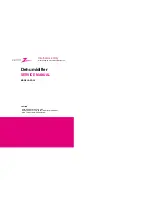
EN
[48]
DEHUMIDIFIER
16. Decommissioning
• Before carrying out this procedure, it is essential that technician
is completely familiar with the equipment and all its detail. It is
recommended good practice that all refrigerants are recovered safely.
Prior to the task being carried out, an oil and refrigerant sample
shall be taken in case analysis is required prior to reuse of reclaimed
refrigerant. It is essential that electrical power is available before the
task is commenced.
a. Become familiar with the equipment and its operation.
b. Isolate system electrically.
c. Before attempting the procedure ensure that: mechanical handling
equipment is available, if repaired, for handling refrigerant cylinders; all
personal protective equipment is available and being used correctly;
the recovery process is supervised at all times by a competent
person; recovery equipment and cylinders conform to the appropriate
standards.
d. Pump down refrigerant system, if possible.
e. If a vacuum is not possible, make a manifold so that refrigerant can be
removed from various parts of the system.
f. Make sure that cylinder is situated on the scales before recovery takes
place.
g. Start the recovery machine and operate in accordance with
manufacturer’s instructions.
h.
Do not overfill cylinders (No more than 80% volume liquid charge).
i. Do not exceed the maximum working pressure of the cylinder, even
temporarily.
j. When the cylinders have been filled correctly and the process
completed, make sure that the cylinders and the equipment are
removed from site promptly and all isolation valves on the equipment
are closed off.
k. Recovered refrigerant shall not be charged into another refrigeration
system unless it has been cleaned and checked.
17. Labelling
• Equipment shall be labelled stating that it has been decommissioned
and emptied of refrigerant. The label shall be dated and signed. Ensure
that there are labels on the equipment stating the equipment contains
flammable refrigerant.
















































